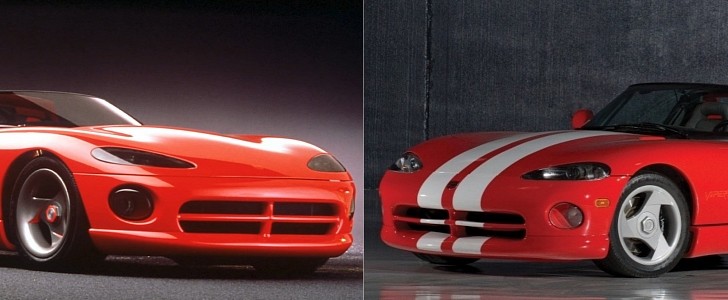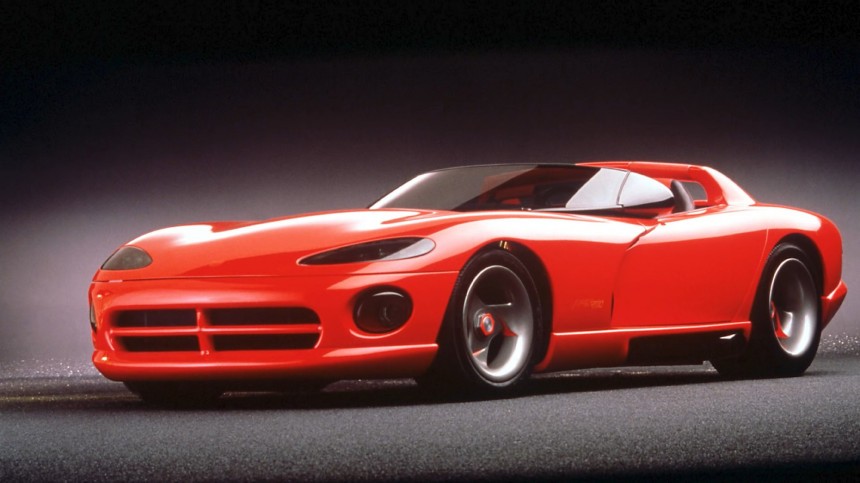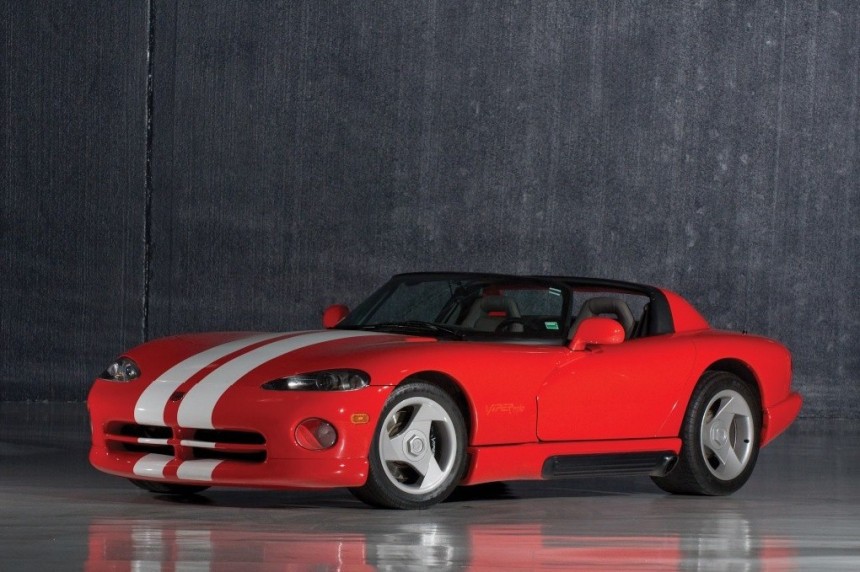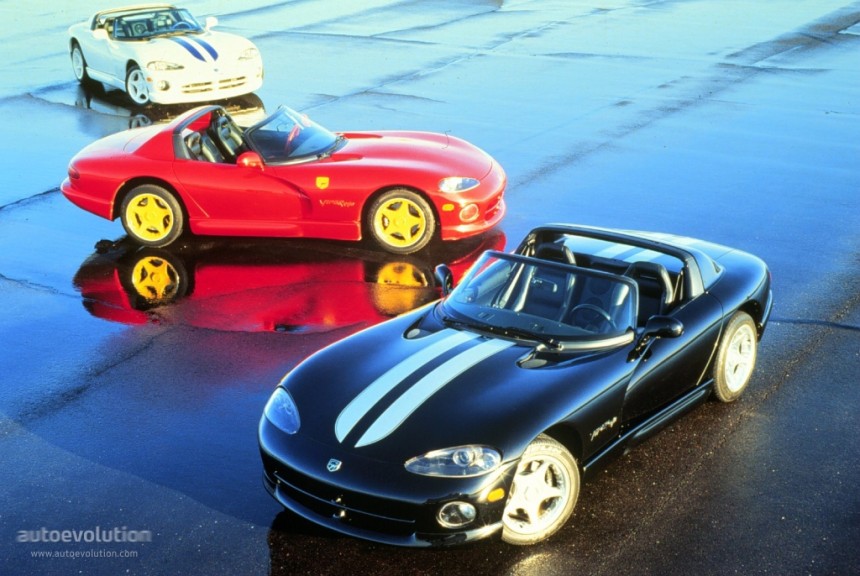Dodge Viper is one example of a production model that exceeded the concept car's promises, and this spectacular machine shook the sports car world at the beginning of the 1990s with its V10 monster engine.
Legend says that after spending a weekend with his 1985 Autocraft MKIV Cobra, Bob Lutz returned to the office and asked the design team to build a modern-day sports car with the same spirit. Of course, since he was Chrysler's president, the answer was yes, and Tom Gale from Chrysler Design Center started to work on sketches.
In those times, Chrysler was selling K-body vehicles such as the Dodge Aries or the Chrysler LeBaron. Their boxy look was outdated, and the sale figures were not among the best on the market. Dodge was far from being what it was intended to be, a performance-oriented brand.
When Bob Lutz first saw the sketches, he said, "I had a vision of the car is closer to a Cobra, and then when I first saw it, I was shocked it wasn't. It very quickly grew up on me, so it's not correct to say, 'never liked.' Better would be 'initially disliked.'" Still, he approved the project, and the design team began work on the full-scale clay model. Based on that, a bodyshop specialist, Metalcrafters from California, made the body panels. At the same time, the engineering department made a chassis for the project.
Dodge unveiled the final result at the 1989 North American International Auto Show (NAIAS). The whole audience was in shock. Moreover, hundreds of customers put a down payment for the final production model, even though Chrysler hadn't decided to build the Viper yet.
When the car was unveiled, it was more of a scam than a finished product. The cooling system was so weak that the car couldn't have been driven more than a few minutes before it started to overheat. But that didn't count. It was driven inside buildings and only up to 5 mph (8 kph) speeds.
People judged it by its looks, and the lower bumper, with the crosshair design, became one of the best-known key elements in the automotive industry. More than three decades after that, it's easy to spot a Dodge just by seeing its specific grille.
The car sported 17" three-spoke alloy wheels, which used Good Year tires, narrower at the front and wider at the rear. Its raked windshield was continued on the sides by the tripod-mounted mirrors. With its smoked headlights and taillights painted in red, the Viper stole the 1989 NAIAS. It didn't even matter that the side exhausts were dangerously exposed.
After the show, Chrysler understood there was a high demand for a hardcore performance sports car. So it assigned a $70 million budget for R&D. The game was on, and Lutz's reputation was at stake. Yet, apart from design, Chrysler didn't have anything for the car. The engine was a joke, the Getrag gearbox was not good for the U.S. market, and many other parts were missing.
At that time, Chrysler owned Lamborghini, who knew how to make a supercar. After all, they created the first one,the Miura, and the longest-production supercar ever, the Countach. A team of engineers left for Italy for more than half of year to learn how to do that V10 properly.
After some hard work, Lamborghini redesigned the engine, made the block from aluminum, and refined all other components. In the end, they finished three V10s and shipped them back to the U.S. along with the American engineers, who learned how to build them.
Two prototypes were built: the VM-01 with a V8 engine and the VM-02 with the real V10 powerplant. These were made to let Chrysler's top executives drive them and get convince to finance the project. It was more or less a PR stunt done internally by the Viper development team.
Peter Gladysz, the Viper powertrain engineer, recalls that "We knew we needed to create something new. And we knew one of the things was a V10. There was a lot of nibbling on a V8. Certainly, from an emission point of view, the V8 was the easier choice." Yet, he didn't take the easiest path, and the V10 promised by the concept car became a reality.
The series-production model was sent for testing in November 1991 and, in January 1992, Dodge started shipping the Viper RT/10 to customers. With a $60,000 starting price, it looked very close to the concept car, or even better, if you ask me. In street clothes, the model featured a taler and not as steep windshield as on the project. Its unusual rearview mirrors from the 1989 show vehicle were gone. They looked like Yoda's ears, in my opinion, and they blocked the driver's view anyway.
Soon, customers found out that the cool-looking side exhausts were not cool at al. They were actually very hot. Even though they were mostly covered, part of them could still get in touch with occupants' feet when exiting the vehicle. Later on, these were replaced by a more conventional layout, with dual rear pipes, centrally mounted.
Like the prototype, the 1992 RT/10 featured a three-spoke steering wheel and a radio. And that ended the car's amenities. The fabric roof was mostly for emergencies only, since there were no side windows. Also, the door locks and handles didn't exist. Since there were no windows, we can understand that an AC unit would have been useless, but why not ABS or traction control? Despite all that, the American V10 sports car (or is it supercar?) was born, it sold 122 units in 1992, and over 1,000 each year after that.
Its monster, 8.0-liter naturally aspirated engine, was its main weapon and main weakness. The car drove like a hammer, with the heaviest parts at the front. It wasn't the best handling car on the market, but its 400 hp V10 and 465 lb-ft of torque more than made up for that. And the Getrag gearbox? Well, it was ditched in favor of a Borg-Warner six-speed manual transmission.
The car could rocket from 0 to 60 mph (0-97 kph) in 4.3 seconds and completed the quarter-mile run in 12.8 seconds. Its 168 mph (270 kph) was good enough to scare Ferrari owners. As for its main rival, the Corvette C4, it could eat it for lunch. Further developments only brought more shine to this spectacular-looking marketing weapon that started only as Bob Lutz's dream, and ended up as being a cult car and not only in America, but all over the world, especially after it won its class in the 1995 Le Mans race.
In those times, Chrysler was selling K-body vehicles such as the Dodge Aries or the Chrysler LeBaron. Their boxy look was outdated, and the sale figures were not among the best on the market. Dodge was far from being what it was intended to be, a performance-oriented brand.
When Bob Lutz first saw the sketches, he said, "I had a vision of the car is closer to a Cobra, and then when I first saw it, I was shocked it wasn't. It very quickly grew up on me, so it's not correct to say, 'never liked.' Better would be 'initially disliked.'" Still, he approved the project, and the design team began work on the full-scale clay model. Based on that, a bodyshop specialist, Metalcrafters from California, made the body panels. At the same time, the engineering department made a chassis for the project.
Dodge unveiled the final result at the 1989 North American International Auto Show (NAIAS). The whole audience was in shock. Moreover, hundreds of customers put a down payment for the final production model, even though Chrysler hadn't decided to build the Viper yet.
People judged it by its looks, and the lower bumper, with the crosshair design, became one of the best-known key elements in the automotive industry. More than three decades after that, it's easy to spot a Dodge just by seeing its specific grille.
The car sported 17" three-spoke alloy wheels, which used Good Year tires, narrower at the front and wider at the rear. Its raked windshield was continued on the sides by the tripod-mounted mirrors. With its smoked headlights and taillights painted in red, the Viper stole the 1989 NAIAS. It didn't even matter that the side exhausts were dangerously exposed.
After the show, Chrysler understood there was a high demand for a hardcore performance sports car. So it assigned a $70 million budget for R&D. The game was on, and Lutz's reputation was at stake. Yet, apart from design, Chrysler didn't have anything for the car. The engine was a joke, the Getrag gearbox was not good for the U.S. market, and many other parts were missing.
After some hard work, Lamborghini redesigned the engine, made the block from aluminum, and refined all other components. In the end, they finished three V10s and shipped them back to the U.S. along with the American engineers, who learned how to build them.
Two prototypes were built: the VM-01 with a V8 engine and the VM-02 with the real V10 powerplant. These were made to let Chrysler's top executives drive them and get convince to finance the project. It was more or less a PR stunt done internally by the Viper development team.
Peter Gladysz, the Viper powertrain engineer, recalls that "We knew we needed to create something new. And we knew one of the things was a V10. There was a lot of nibbling on a V8. Certainly, from an emission point of view, the V8 was the easier choice." Yet, he didn't take the easiest path, and the V10 promised by the concept car became a reality.
Soon, customers found out that the cool-looking side exhausts were not cool at al. They were actually very hot. Even though they were mostly covered, part of them could still get in touch with occupants' feet when exiting the vehicle. Later on, these were replaced by a more conventional layout, with dual rear pipes, centrally mounted.
Like the prototype, the 1992 RT/10 featured a three-spoke steering wheel and a radio. And that ended the car's amenities. The fabric roof was mostly for emergencies only, since there were no side windows. Also, the door locks and handles didn't exist. Since there were no windows, we can understand that an AC unit would have been useless, but why not ABS or traction control? Despite all that, the American V10 sports car (or is it supercar?) was born, it sold 122 units in 1992, and over 1,000 each year after that.
Its monster, 8.0-liter naturally aspirated engine, was its main weapon and main weakness. The car drove like a hammer, with the heaviest parts at the front. It wasn't the best handling car on the market, but its 400 hp V10 and 465 lb-ft of torque more than made up for that. And the Getrag gearbox? Well, it was ditched in favor of a Borg-Warner six-speed manual transmission.
The car could rocket from 0 to 60 mph (0-97 kph) in 4.3 seconds and completed the quarter-mile run in 12.8 seconds. Its 168 mph (270 kph) was good enough to scare Ferrari owners. As for its main rival, the Corvette C4, it could eat it for lunch. Further developments only brought more shine to this spectacular-looking marketing weapon that started only as Bob Lutz's dream, and ended up as being a cult car and not only in America, but all over the world, especially after it won its class in the 1995 Le Mans race.





















